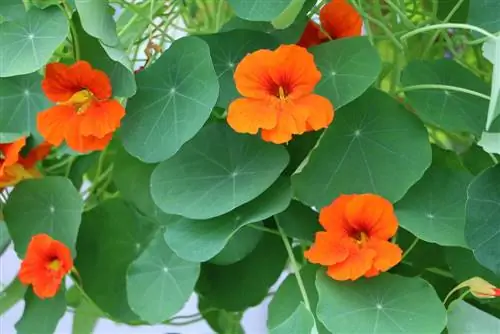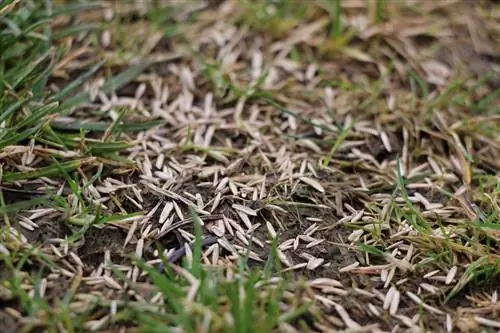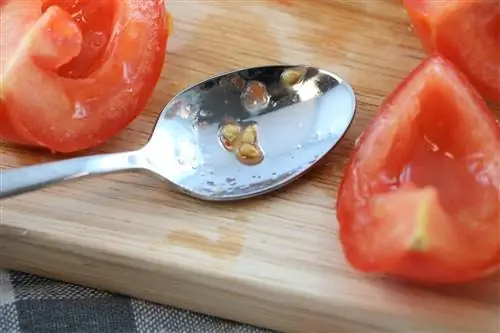- Author admin [email protected].
- Public 2023-12-17 03:39.
- Last modified 2025-06-01 06:48.
Nasturtium grows almost unbeatably fast, is almost unbeatably easy to grow and care for and produces an almost unbeatably bountiful harvest - do you need more arguments to grow a plant? Here you go, the nasturtium also has some culinary talents, and its greens are very he althy:
Location and soil
Nasturtium can become a real eye-catcher in the garden if you give it a place where it can twine its long tendrils up decoratively. Then she can have a fence that needs painting, 666kb.com/i/aeagxvtidgukhfgvo.jpg, a house entrance, djv-bildportal.de/s/image/Napuzinerkresse-Tropaeolum-majus-kletternd-an-Rankhilfe-Zaun-essbare-Bl-ten-W-rz plante-Salat-K-che-Garten-0003168437.jpg, or effectively beautify the compost heap, www.schmeck-den-sueden.de/wp-content/uploads/2013/08/kapuzinerkresse-general.jpg.
The nasturtium can also be beneficial in its location, it has not acquired its aromatic scent without ulterior motives, but to ward off pests, you can use that:
- Nasturtium repels scale insects, aphids and other lice, caterpillars and snails (also from neighboring plants)
- You could plant nasturtiums as a bed border, then the plants in the bed will have peace from the plant suckers and nibblers
- Nasturtium is said to do well next to/around cauliflower, broccoli, fennel, kohlrabi, radish and celery
- Also under apple trees and peach trees and next to roses
- Best non-climbing nasturtiums together with garlic
- Organic gardeners like to use nasturtiums in mixed culture
- Nasturtiums also look good next to cabbage; the caterpillars of the cabbage white butterfly are said to eat them rather than cabbage
But that doesn't mean that the miracle cure nasturtium will drive every aphid out of the garden. There are several hundred species of them, some of which have completely different preferences than nasturtiums or cauliflower/apple blossoms. In the long term, only natural garden management without monocultures and economical (targeted) use of nitrogen fertilizer can help against excessive aphid proliferation. Gardens with monocultures that are remote from nature have hardly any soil life to offer and “untidy” areas with plant remains, which provide food, breeding and shelter for aphids' predators; plants that grow excessively due to a lot of nitrogen are a feast for aphids. Only in a garden where nature exists can a natural ecological balance be established in which aphids are reduced to tolerable populations.
Nasturtium grows in any garden soil, preferably in humus-rich, loose, water-permeable, not too nutritious soil. It also grows on heavy and nutrient-rich soils, but only develops a few flowers. No problem if you're more keen on he althy greens than decoration anyway. If you want to grow a lot of flowers, you should loosen and enrich the soil by mixing in sand. Nasturtium grows in the sun and in light partial shade; when there is little sunlight, it produces more leaves than flowers. If the location gets more sun, not only will there be more flowers, but the taste of the cress will also become more intense and the scent will be stronger. It would be perfect if there was cool (shaded) weather in the lower area. If the nasturtium gets too much heat around the roots, it stops development and the lower leaves dry out. The gardener himself can also benefit from the location of the nasturtium: Nasturtium looks particularly good near a seat. It is a real fragrance star, with some fairly rare advantages: In contrast to many other aromatic herbs, which only release their smell when strongly requested (broken /Grinding), nasturtium does not need any stimulation/destruction to smell, just a small breeze.
Selection of species/varieties
Before you start sowing, you now have to decide on a specific nasturtium, there are several types and varieties:
- The Great Nasturtium is the nasturtium whose flowers you will recognize if you have dined at a gourmet restaurant in recent years. This Tropaeolum majus is actually perennial (biennial to perennial, sources vary), but we usually only cultivate it as an annual because overwintering requires a bit of effort and sowing is super quick and easy. This nasturtium grows as a ground cover or as a climbing plant and reaches heights of 30 cm to 4 m. The natural variety blooms orange-red, the cultivated varieties from 'Alaska' to 'Salmon Gleam' show all possible flower colors.
- The small nasturtium Tropaeolum minus grows bushy in most varieties and only 20 - 30 cm high. But there are also climbing varieties and varieties that grow overhanging with flowers above the foliage, ideal for hanging baskets. The numerous cultivars from 'Black Velvet' to 'Whirlybird Gold' show very beautiful and very different flower colors.
- The Canary Islands nasturtium Tropaeolum peregrinum is a delicate nasturtium with exotic lemon-yellow, heavily fringed flowers that add attractive greenery to sunny and partially shaded trellises and trellises.
- The tuberous nasturtium Tropaeolum tuberosum is very decorative and a little more productive than the other species, because even the tuber is intended for consumption. This has long been used as food in South America, can be cooked like a potato, but is said to taste even better.
Buying and sowing seeds
The only thing left to do before sowing is to buy it, and with nasturtiums you can't do that at the nearest discount store. Choosing the right seeds is not unimportant, especially if you want to pamper and impress guests with the leaves and flowers. Today, conventional seeds are usually treated with pesticides, against fungal infestation and pests (which, according to the definition of plant production, also include birds), with fungicides and/or insecticides. The active ingredient in the dressing can get into the growing parts of the plant, which, according to many people, is noticeable in the taste.
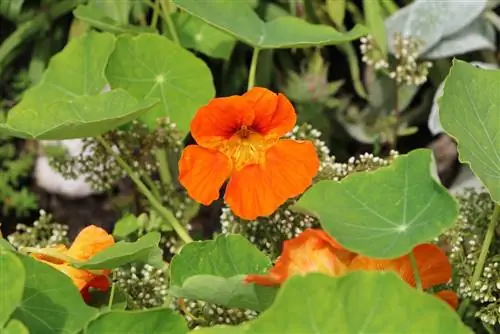
That's not all the harmful effects, the stains are often highly toxic, e.g. B. Grain dressings: Clothianidin, Cyfluthrin, Cyproconazole. Difenoconazole, Dimethomorph, Fludioxonil, Fluoxastrobin, Fuberidazole, Imazalil, Imidacloprid, Metalaxyl, Methiocarb, Prochloraz, Prothioconazole, Pyrimethanil, Silthiofam, Tebuconazole, Thiamethoxam, Thiram, Triadimenol, Triazoxide, Triticonazole, Ziram. You can read it at de.wikipedia.org/wiki/Beizen_(Pflanzenschutz), where for each product there is a link to the page with the hazardous substance labeling (=can probably harm the child in the womb, very toxic for aquatic organisms with long-term effects, etc.). There are no generally available sources on which seed dressing is used in other areas of seed production. For nasturtiums you will only find information such as “our seeds are not chemically or electronically treated”. Given the poisons just listed, it is certainly not a bad idea to have exactly such information to search.
Once you have purchased the seeds that you are sure will produce plants that will not harm you or your guests, then you can start growing nasturtiums, which is child's play compared to dealing with seed dressing:
- For very dry/slightly older seeds you can make your own seed dressing
- Simple chamomile tea, soak for five hours, promotes germination and disinfects
- Grow in the pot until April, nasturtiums germinate best at soil temperatures between 15 - 18 °C
- Or sow outdoors from mid-May
- Nasturtium can be sown until the end of July so that you can still see harvestable cress
- The seeds can be spread widely or in rows
- Nasturtium is one of the dark germinators, the seeds germinate more poorly in/with light
- Rows are pulled forward and then raked up
- When sowing by litter, a wheelbarrow with soil should be available to spread over the sowing
- Sowing in pots works similarly, but you should distribute the seeds well
- Nasturtiums don't like to be transplanted, so pricking out is no longer necessary
Care
Do you know which plant is used to find out whether a soil is e.g. B. is already so dead that nothing grows in him anymore? Because it always germinates when plant life is possible in the soil/substrate? The cress, the so-called cress test, is a well-known bioindication procedure. The other way around, this means that you don't have to worry much about cress in he althy garden soil. You are doing your own cress test, so to speak, if the nasturtium is in any way restricted or has strange germination or growth, that would certainly be a reason for a thorough soil analysis.
With the simplest basic care, the nasturtium should thrive:
- Keep moist throughout the germination phase
- Later, the nasturtium can tolerate a little more drought, the soil is allowed to dry out between watering
- If the nasturtium gets too dry, it immediately drops its leaves
- In the summer it has to provide a lot of plant mass, during hot summer days it has to be watered every day
- Nasturtium blooms from June/July to September/October, removing spent flowers allows new ones to appear
- The garden is fertilized with compost or organic fertilizer for crops (vegetable fertilizer)
- In the pot, the nasturtium can receive liquid fertilizer or fertilizer sticks in half the concentration
Harvesting, propagating, overwintering
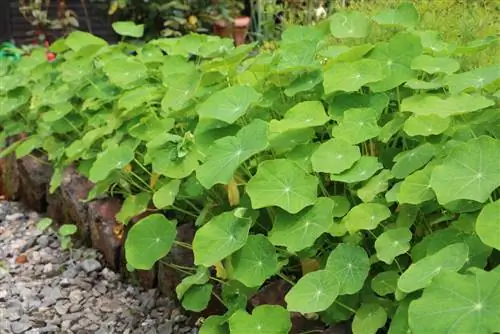
The harvest can begin when the first young, tender leaves are large enough, they go into salads or on bread. Soon after, the first flowers appear (and many more flowers and leaves until the first frost), very pretty edible decorations. You can then soak the closed flower buds and young seeds in herbal vinegar and use them like capers. You can propagate nasturtiums using seeds and cuttings. The frost-sensitive nasturtium is unlikely to overwinter in the garden, but with a bit of luck a few seeds will survive in the ground and germinate in spring; It's not uncommon, so let a few flowers ripen on the plant. A pot with nasturtiums can be overwintered, according to the prevailing opinion in a bright and frost-free location, and according to another opinion also in the cellar.
Conclusion
Nasturtiums in the garden or in a pot are definitely a good idea. Not just because of its beauty, delicious taste and easy handling - the “Medicinal Plant of the Year 2013” also does a lot to keep you he althy.

